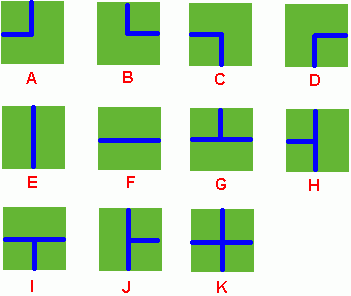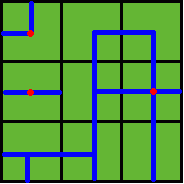Farm Irrigation
Time Limit: 2000/1000 MS (Java/Others) Memory Limit: 65536/32768 K (Java/Others)
Total Submission(s): 12884 Accepted Submission(s): 5534
Problem Description
Benny
has a spacious farm land to irrigate. The farm land is a rectangle, and
is divided into a lot of samll squares. Water pipes are placed in these
squares. Different square has a different type of pipe. There are 11
types of pipes, which is marked from A to K, as Figure 1 shows.

Figure 1
Benny has a map of his farm, which is an array of marks denoting the distribution of water pipes over the whole farm. For example, if he has a map
ADC
FJK
IHE
then the water pipes are distributed like

Figure 2
Several wellsprings are found in the center of some squares, so water can flow along the pipes from one square to another. If water flow crosses one square, the whole farm land in this square is irrigated and will have a good harvest in autumn.
Now Benny wants to know at least how many wellsprings should be found to have the whole farm land irrigated. Can you help him?
Note: In the above example, at least 3 wellsprings are needed, as those red points in Figure 2 show.

Benny has a map of his farm, which is an array of marks denoting the distribution of water pipes over the whole farm. For example, if he has a map
ADC
FJK
IHE
then the water pipes are distributed like

Several wellsprings are found in the center of some squares, so water can flow along the pipes from one square to another. If water flow crosses one square, the whole farm land in this square is irrigated and will have a good harvest in autumn.
Now Benny wants to know at least how many wellsprings should be found to have the whole farm land irrigated. Can you help him?
Note: In the above example, at least 3 wellsprings are needed, as those red points in Figure 2 show.
Input
There
are several test cases! In each test case, the first line contains 2
integers M and N, then M lines follow. In each of these lines, there are
N characters, in the range of 'A' to 'K', denoting the type of water
pipe over the corresponding square. A negative M or N denotes the end of
input, else you can assume 1 <= M, N <= 50.
Output
For each test case, output in one line the least number of wellsprings needed.
Sample Input
2 2
DK
HF
3 3
ADC
FJK
IHE
-1 -1
Sample Output
2
3
题目大意与分析
给出水管的种类,求出联通集的个数
判断每个格子能否和左边与上边的水管联通,如果能连通就加入并查集即可
注意二维数组与一维数组下标的转化问题,如果n行m列,那么一维数组下标是i*m+j
#include<bits/stdc++.h> using namespace std; char mp[55][55]; int n,m,i,j,s[5005],sum; int pd_upanddown(int a,int b) { int x1=a/m; int y1=a%m; int x2=b/m; int y2=b%m; if(mp[x1][y1]=='A'||mp[x1][y1]=='B'||mp[x1][y1]=='F'||mp[x1][y1]=='G') { return 0; } else if(mp[x2][y2]=='C'||mp[x2][y2]=='D'||mp[x2][y2]=='F'||mp[x2][y2]=='I') { return 0; } else { return 1; } } int pd_leftandright(int a,int b) { int x1=a/m; int y1=a%m; int x2=b/m; int y2=b%m; if(mp[x1][y1]=='A'||mp[x1][y1]=='C'||mp[x1][y1]=='E'||mp[x1][y1]=='H') { return 0; } else if(mp[x2][y2]=='B'||mp[x2][y2]=='D'||mp[x2][y2]=='E'||mp[x2][y2]=='J') { return 0; } else { return 1; } } int findf(int x) { return x==s[x]?x:s[x]=findf(s[x]); } void hebing(int a,int b) { int fa=findf(a); int fb=findf(b); if(fa!=fb) { s[fb]=fa; } } int main() { while(~scanf("%d%d",&n,&m)) { sum=0; if(m<0||n<0) { return 0; } for(i=0;i<n;i++) { for(j=0;j<m;j++) { s[i*m+j]=i*m+j; } } for(i=0;i<n;i++) { scanf("%s",&mp[i]); } for(i=0;i<n;i++) { for(j=0;j<m;j++) { if(i==0&&j==0) { continue; } else if(i==0) { if(pd_leftandright(i*m+j-1,i*m+j)) { hebing(i*m+j-1,i*m+j); } } else if(j==0) { if(pd_upanddown(i*m+j-m,i*m+j)) { hebing(i*m+j-m,i*m+j); } } else { if(pd_leftandright(i*m+j-1,i*m+j)) { hebing(i*m+j-1,i*m+j); } if(pd_upanddown(i*m+j-m,i*m+j)) { hebing(i*m+j-m,i*m+j); } } } } for(i=0;i<n;i++) { for(j=0;j<m;j++) { if(findf(i*m+j)==(i*m+j)) { sum++; //cout<<i<<" "<<j<<endl; } } } printf("%d ",sum); } }